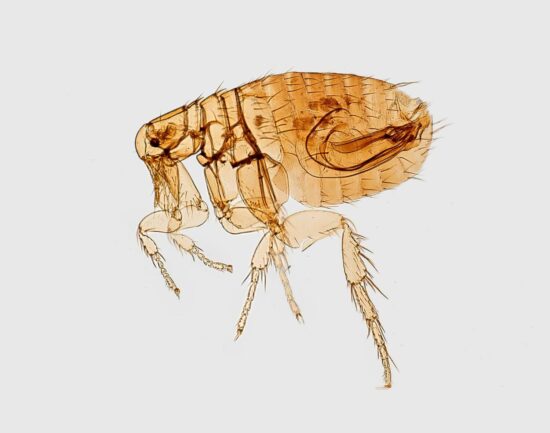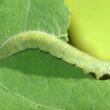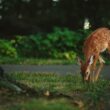Fleas are tiny bugs that can cause big problems for pets and people. These jumping insects are parasites, which means they live on other animals and feed off them. Understanding what fleas eat is important for getting rid of them and keeping them away from your home.
Adult fleas and baby fleas (called larvae) eat very different things. Adult fleas need blood to survive, while baby fleas eat organic matter they find around the house. Knowing what fleas eat at each stage of their life helps you target them more effectively.
1. Fresh Blood from Pets and Other Animals
Adult fleas absolutely need blood to live. This is their main food source, and they get it by biting cats, dogs, and other furry animals. Fleas have special mouth parts that work like tiny needles to pierce skin and suck blood.
Female fleas are the biggest blood drinkers. They can consume over 15 times their body weight in blood every single day. That might sound like a lot, but fleas are so tiny that this amount won’t hurt your pet. A typical flea finishes drinking blood in just 5 minutes, though some take up to an hour.
No products found.
When fleas bite, they inject saliva that stops blood from clotting. This makes it easier for them to feed, but it also causes the itchy bumps that drive pets crazy. Female fleas need lots of blood because they use it to make eggs. Without blood meals, fleas can’t reproduce.
2. Human Blood When Pets Aren’t Available
Even though fleas prefer furry animals, they will bite humans when they need to. What fleas eat includes human blood, but people aren’t their favorite choice. Fleas have a much harder time staying on humans because we don’t have thick fur to hide in.
When fleas do bite people, they don’t stay attached very long. Female fleas typically feed on humans for about 7 minutes, while males only feed for about 4 minutes. They often bite 2 or 3 times before jumping away to look for a better host.
Fleas can actually survive on human blood alone if they have to. Scientists have found that fleas can live for 4 to 6 months feeding only on human blood. However, female fleas that eat only human blood produce much fewer eggs than those feeding on cats or dogs.
3. Flea Poop and Dried Blood
This might sound gross, but baby fleas (larvae) depend on adult flea poop to survive. When adult fleas drink blood, they can’t digest all of it. They poop out the extra blood in tiny dark specks called “flea dirt.”
Flea larvae eat this flea dirt as their main food source. The dried blood gives them the nutrients they need to grow. Without flea poop, baby fleas cannot survive at all. Female fleas produce much more poop than males, which helps feed more larvae.
You might find flea dirt on your pet’s fur or in areas where your pet sleeps. It looks like tiny black or dark red specks. If you put flea dirt on a wet paper towel, it will turn reddish brown because it contains digested blood.
4. Dead Skin Cells and Hair
Baby fleas are like tiny vacuum cleaners that eat up organic matter around your house. What fleas eat during their larval stage includes dead skin cells that fall off people and pets, along with bits of hair and fur.
These skin cells and hair pieces are everywhere in homes with pets. They collect in carpets, pet bedding, cracks in floors, and under furniture. Flea larvae crawl around these areas looking for food. They’re really good at finding these tiny food particles.
The larvae use their small mouth parts to chew up skin cells and hair. This gives them protein and other nutrients they need to grow bigger. Areas where pets spend a lot of time usually have the most of this type of food for baby fleas.
5. Food Crumbs and Organic Debris
Flea larvae aren’t picky eaters. They will munch on almost any organic matter they can find around the house. This includes tiny food crumbs, dust, and other bits of organic debris that accumulate over time.
What fleas eat at the larval stage helps explain why they’re often found in kitchens, dining rooms, and anywhere food might drop. Even microscopic crumbs provide nutrition for growing larvae. They’re especially drawn to areas under pet food bowls and around eating areas.
These tiny scavengers help clean up organic waste, though that’s definitely not a good reason to want them around. The larvae are very small and can fit into tight spaces where they find forgotten food particles that regular cleaning might miss.
6. Other Flea Eggs and Baby Fleas
No products found.
When food is hard to find, flea larvae will eat each other. This cannibalistic behavior happens more often when too many larvae are crowded together in one area. Bigger larvae will eat smaller ones and even flea eggs.
This might seem mean, but it’s actually a survival strategy. When there isn’t enough food to go around, the stronger larvae eliminate competition by eating the weaker ones. This ensures that at least some fleas will survive to become adults.
Scientists have noticed that flea larvae need variety in their diet to develop properly. Larvae that only eat one type of food don’t grow as well as those that eat many different things. This includes eating other larvae when necessary.
7. Feathers and Bird Materials
Some types of fleas live on birds instead of mammals. These bird fleas and their larvae eat feathers and other materials found around bird nests. Feathers contain keratin, which provides good nutrition for growing larvae.
Bird fleas work the same way as cat and dog fleas, but they’re specialized for living on feathered hosts. The larvae eat bits of feathers, bird skin, and other organic matter found in nesting areas. This is less common in most homes unless you have pet birds.
What do fleas eat when they live on birds includes all the same blood and organic matter, just from bird sources instead of mammal sources. The basic feeding patterns remain the same across different flea species.
8. Plant Matter and Vegetable Debris
While fleas are primarily blood feeders, their larvae will eat small amounts of plant matter when other food is scarce. This includes tiny bits of leaves, grass, and other vegetable materials that might blow into the house or get tracked in on shoes.
Plant matter doesn’t provide great nutrition for flea larvae, but it can help them survive when better food sources are limited. Larvae that eat only blood products grow much better than those that have to rely on plant materials.
Studies show that larvae need a mixed diet to develop properly. Those fed only blood don’t do as well as those that get variety in what fleas eat. However, too much plant matter and not enough protein can also cause problems for developing larvae.
9. Blood from Wild Animals
Fleas don’t just live on pets. They also feed on wild animals like squirrels, rabbits, mice, and raccoons. These wild animals can bring fleas into your yard, where the fleas might then jump onto your pets.
Livestock animals like cattle, sheep, and goats can also host fleas. Farm fleas work the same way as house fleas, feeding on blood and laying eggs in areas where animals rest. Wild animal fleas help flea populations survive even when pets aren’t around.
Urban wildlife creates a constant source of fleas in many neighborhoods. Stray cats, opossums, raccoons, and other animals carry fleas that can spread to nearby homes. This is why flea control sometimes requires treating outdoor areas too.
10. Surviving Without Food
Fleas are surprisingly tough when it comes to surviving without food. Adult fleas that get separated from their host animal will die within about 4 days from starvation. However, young fleas that have never eaten can last about a week without food.
The most impressive survivors are baby fleas still inside their cocoons. These pre adult fleas can wait up to 5 months without eating anything. They stay dormant until they sense a potential host nearby, then quickly emerge to start feeding.
This survival ability makes fleas really hard to get rid of. Even after treating pets and cleaning the house, fleas can emerge weeks later from their hiding spots. They can wait patiently in carpets, under furniture, and in other protected areas until conditions improve.
Understanding what fleas eat at every stage of their life cycle is key to effective pest control. Adult fleas need blood to survive and reproduce, while baby fleas scavenge organic matter from the environment. Successful flea control requires targeting both life stages where they eat and live.


